PONTIAC VIBE 2010 Owners Manual
Manufacturer: PONTIAC, Model Year: 2010, Model line: VIBE, Model: PONTIAC VIBE 2010Pages: 318, PDF Size: 1.7 MB
Page 231 of 318
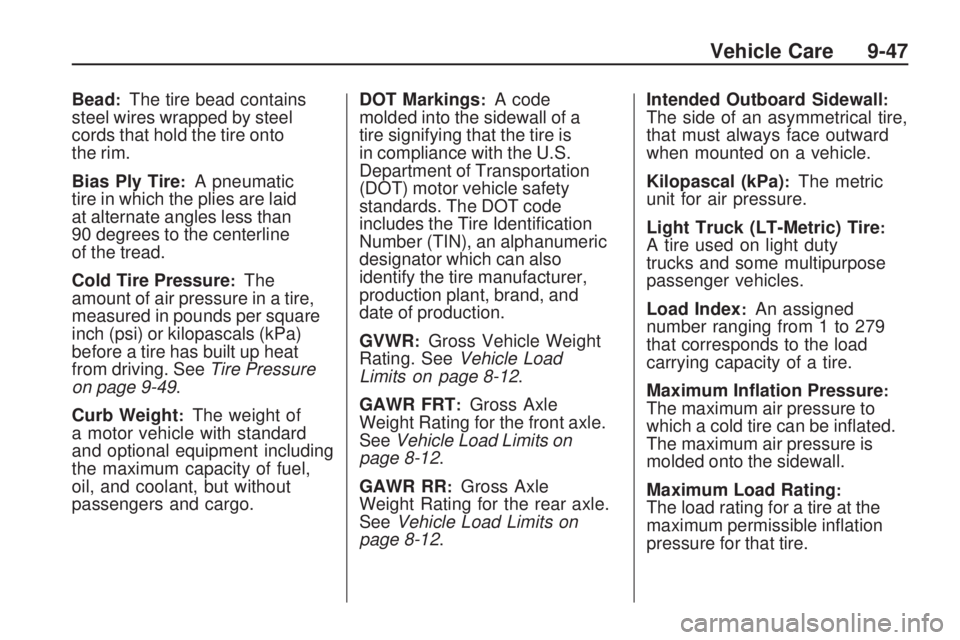
Bead:The tire bead contains
steel wires wrapped by steel
cords that hold the tire onto
the rim.
Bias Ply Tire
:A pneumatic
tire in which the plies are laid
at alternate angles less than
90 degrees to the centerline
of the tread.
Cold Tire Pressure
:The
amount of air pressure in a tire,
measured in pounds per square
inch (psi) or kilopascals (kPa)
before a tire has built up heat
from driving. See Tire Pressure
on page 9-49.
Curb Weight
:The weight of
a motor vehicle with standard
and optional equipment including
the maximum capacity of fuel,
oil, and coolant, but without
passengers and cargo. DOT Markings
:A code
molded into the sidewall of a
tire signifying that the tire is
in compliance with the U.S.
Department of Transportation
(DOT) motor vehicle safety
standards. The DOT code
includes the Tire Identification
Number (TIN), an alphanumeric
designator which can also
identify the tire manufacturer,
production plant, brand, and
date of production.
GVWR
:Gross Vehicle Weight
Rating. See Vehicle Load
Limits on page 8-12.
GAWR FRT
:Gross Axle
Weight Rating for the front axle.
See Vehicle Load Limits on
page 8-12.
GAWR RR
:Gross Axle
Weight Rating for the rear axle.
See Vehicle Load Limits on
page 8-12. Intended Outboard Sidewall
:The side of an asymmetrical tire,
that must always face outward
when mounted on a vehicle.
Kilopascal (kPa)
:The metric
unit for air pressure.
Light Truck (LT-Metric) Tire
:A tire used on light duty
trucks and some multipurpose
passenger vehicles.
Load Index
:An assigned
number ranging from 1 to 279
that corresponds to the load
carrying capacity of a tire.
Maximum In�ation Pressure
:The maximum air pressure to
which a cold tire can be inflated.
The maximum air pressure is
molded onto the sidewall.
Maximum Load Rating
:The load rating for a tire at the
maximum permissible inflation
pressure for that tire.
Vehicle Care 9-47
Page 232 of 318
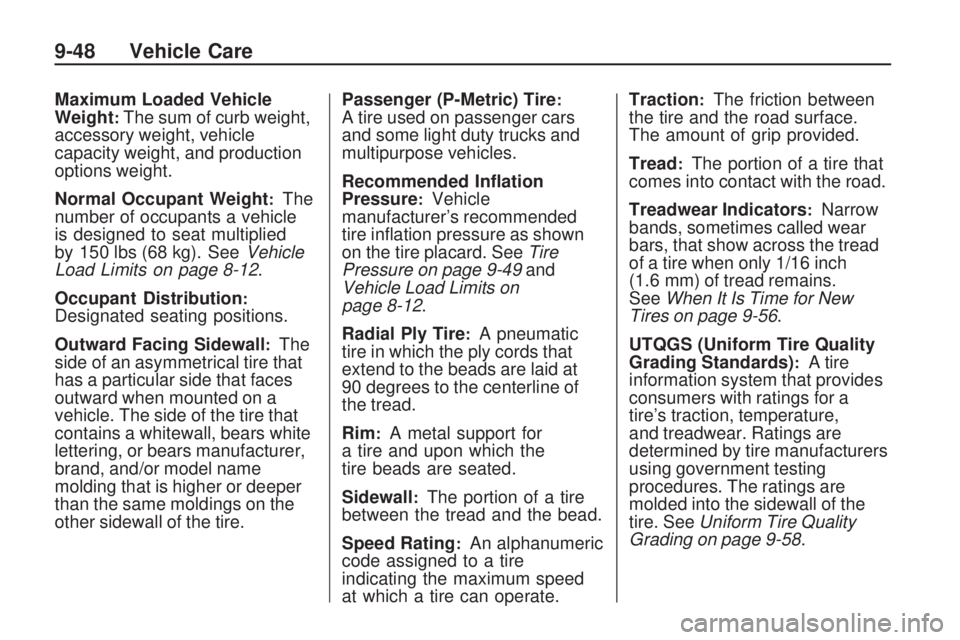
Maximum Loaded Vehicle
Weight:The sum of curb weight,
accessory weight, vehicle
capacity weight, and production
options weight.
Normal Occupant Weight
:The
number of occupants a vehicle
is designed to seat multiplied
by 150 lbs (68 kg). See Vehicle
Load Limits on page 8-12.
Occupant Distribution
:Designated seating positions.
Outward Facing Sidewall
:The
side of an asymmetrical tire that
has a particular side that faces
outward when mounted on a
vehicle. The side of the tire that
contains a whitewall, bears white
lettering, or bears manufacturer,
brand, and/or model name
molding that is higher or deeper
than the same moldings on the
other sidewall of the tire. Passenger (P-Metric) Tire
:A tire used on passenger cars
and some light duty trucks and
multipurpose vehicles.
Recommended In�ation
Pressure
:Vehicle
manufacturer’s recommended
tire inflation pressure as shown
on the tire placard. See Tire
Pressure on page 9-49 and
Vehicle Load Limits on
page 8-12.
Radial Ply Tire
:A pneumatic
tire in which the ply cords that
extend to the beads are laid at
90 degrees to the centerline of
the tread.
Rim
:A metal support for
a tire and upon which the
tire beads are seated.
Sidewall
:The portion of a tire
between the tread and the bead.
Speed Rating
:An alphanumeric
code assigned to a tire
indicating the maximum speed
at which a tire can operate. Traction
:The friction between
the tire and the road surface.
The amount of grip provided.
Tread
:The portion of a tire that
comes into contact with the road.
Treadwear Indicators
:Narrow
bands, sometimes called wear
bars, that show across the tread
of a tire when only 1/16 inch
(1.6 mm) of tread remains.
See When It Is Time for New
Tires on page 9-56.
UTQGS (Uniform Tire Quality
Grading Standards)
:A tire
information system that provides
consumers with ratings for a
tire’s traction, temperature,
and treadwear. Ratings are
determined by tire manufacturers
using government testing
procedures. The ratings are
molded into the sidewall of the
tire. See Uniform Tire Quality
Grading on page 9-58.
9-48 Vehicle Care
Page 233 of 318
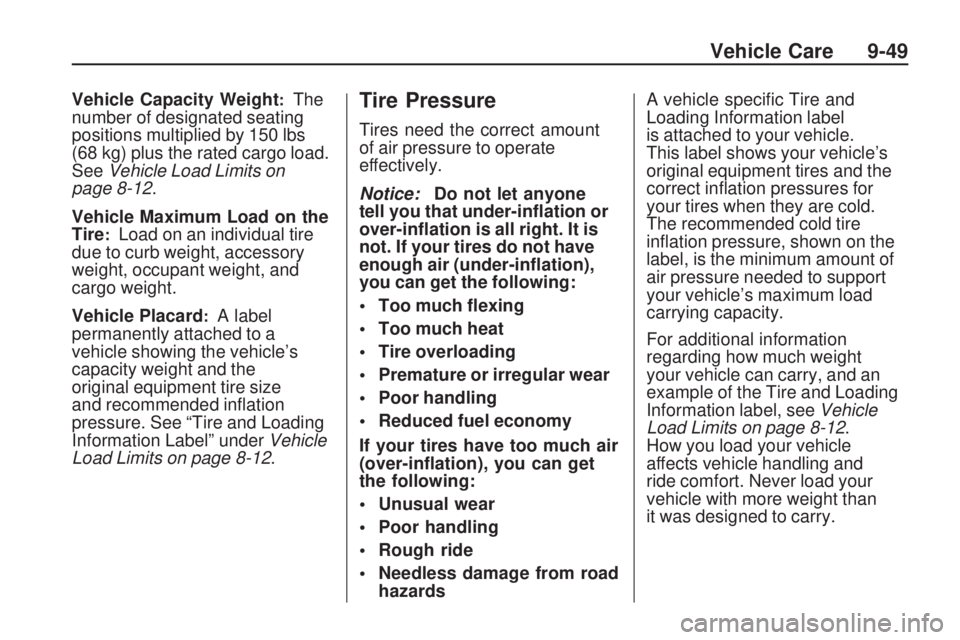
Vehicle Capacity Weight:The
number of designated seating
positions multiplied by 150 lbs
(68 kg) plus the rated cargo load.
See Vehicle Load Limits on
page 8-12.
Vehicle Maximum Load on the
Tire
:Load on an individual tire
due to curb weight, accessory
weight, occupant weight, and
cargo weight.
Vehicle Placard
:A label
permanently attached to a
vehicle showing the vehicle’s
capacity weight and the
original equipment tire size
and recommended inflation
pressure. See “Tire and Loading
Information Label” under Vehicle
Load Limits on page 8-12 .
Tire Pressure
Tires need the correct amount
of air pressure to operate
effectively.
Notice:Do not let anyone
tell you that under-in�ation or
over-in�ation is all right. It is
not. If your tires do not have
enough air (under-in�ation),
you can get the following:
Too much �exing
Too much heat
Tire overloading
Premature or irregular wear
Poor handling
Reduced fuel economy
If your tires have too much air
(over-in�ation), you can get
the following:
Unusual wear
Poor handling
Rough ride
Needless damage from road hazards A vehicle specific Tire and
Loading Information label
is attached to your vehicle.
This label shows your vehicle’s
original equipment tires and the
correct inflation pressures for
your tires when they are cold.
The recommended cold tire
inflation pressure, shown on the
label, is the minimum amount of
air pressure needed to support
your vehicle’s maximum load
carrying capacity.
For additional information
regarding how much weight
your vehicle can carry, and an
example of the Tire and Loading
Information label, see
Vehicle
Load Limits on page 8-12 .
How you load your vehicle
affects vehicle handling and
ride comfort. Never load your
vehicle with more weight than
it was designed to carry.
Vehicle Care 9-49
Page 234 of 318
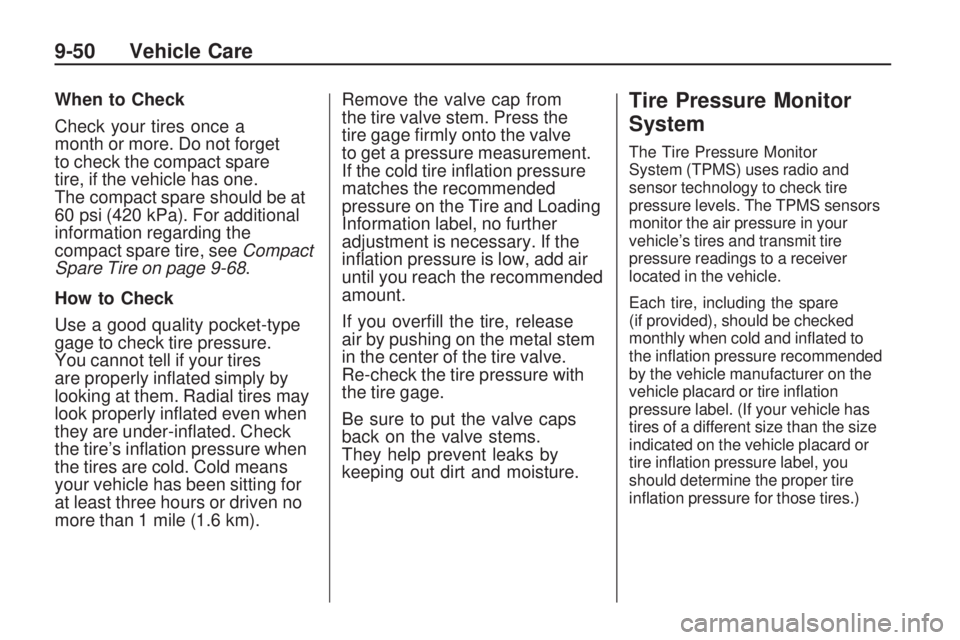
When to Check
Check your tires once a
month or more. Do not forget
to check the compact spare
tire, if the vehicle has one.
The compact spare should be at
60 psi (420 kPa). For additional
information regarding the
compact spare tire, seeCompact
Spare Tire on page 9-68.
How to Check
Use a good quality pocket-type
gage to check tire pressure.
You cannot tell if your tires
are properly inflated simply by
looking at them. Radial tires may
look properly inflated even when
they are under-inflated. Check
the tire’s inflation pressure when
the tires are cold. Cold means
your vehicle has been sitting for
at least three hours or driven no
more than 1 mile (1.6 km). Remove the valve cap from
the tire valve stem. Press the
tire gage firmly onto the valve
to get a pressure measurement.
If the cold tire inflation pressure
matches the recommended
pressure on the Tire and Loading
Information label, no further
adjustment is necessary. If the
inflation pressure is low, add air
until you reach the recommended
amount.
If you overfill the tire, release
air by pushing on the metal stem
in the center of the tire valve.
Re-check the tire pressure with
the tire gage.
Be sure to put the valve caps
back on the valve stems.
They help prevent leaks by
keeping out dirt and moisture.Tire Pressure Monitor
System
The Tire Pressure Monitor
System (TPMS) uses radio and
sensor technology to check tire
pressure levels. The TPMS sensors
monitor the air pressure in your
vehicle’s tires and transmit tire
pressure readings to a receiver
located in the vehicle.
Each tire, including the spare
(if provided), should be checked
monthly when cold and inflated to
the inflation pressure recommended
by the vehicle manufacturer on the
vehicle placard or tire inflation
pressure label. (If your vehicle has
tires of a different size than the size
indicated on the vehicle placard or
tire inflation pressure label, you
should determine the proper tire
inflation pressure for those tires.)
9-50 Vehicle Care
Page 235 of 318

As an added safety feature, your
vehicle has been equipped with
a tire pressure monitoring system
(TPMS) that illuminates a low
tire pressure telltale when one or
more of your tires is significantly
under-inflated.
Accordingly, when the low tire
pressure telltale illuminates, you
should stop and check your tires
as soon as possible, and inflate
them to the proper pressure. Driving
on a significantly under-inflated tire
causes the tire to overheat and can
lead to tire failure. Under-inflation
also reduces fuel efficiency and
tire tread life, and may affect the
vehicle’s handling and stopping
ability.
Please note that the TPMS is
not a substitute for proper tire
maintenance, and it is the driver’s
responsibility to maintain correcttire pressure, even if under-inflation
has not reached the level to trigger
illumination of the TPMS low tire
pressure telltale.
Your vehicle has also been
equipped with a TPMS malfunction
indicator to indicate when the system
is not operating properly. The TPMS
malfunction indicator is combined
with the low tire pressure telltale.
When the system detects a
malfunction, the telltale will flash
for approximately one minute and
then remain continuously illuminated.
This sequence will continue upon
subsequent vehicle start-ups as long
as the malfunction exists.
When the malfunction indicator
is illuminated, the system may not
be able to detect or signal low tire
pressure as intended. TPMS
malfunctions may occur for a variety
of reasons, including the installation
of replacement or alternate tires orwheels on the vehicle that prevent
the TPMS from functioning properly.
Always check the TPMS malfunction
telltale after replacing one or more
tires or wheels on your vehicle to
ensure that the replacement or
alternate tires and wheels allow
the TPMS to continue to function
properly.
See
Tire Pressure Monitor
Operation on page 9-52 for
additional information.
Federal Communications
Commission (FCC) and
Industry and Science Canada
See Radio Frequency Statement
(US, Can) on page 12-16 for
information regarding Part 15
of the Federal Communications
Commission (FCC) Rules and
RSS-210/211 of Industry and
Science Canada.
Vehicle Care 9-51
Page 236 of 318
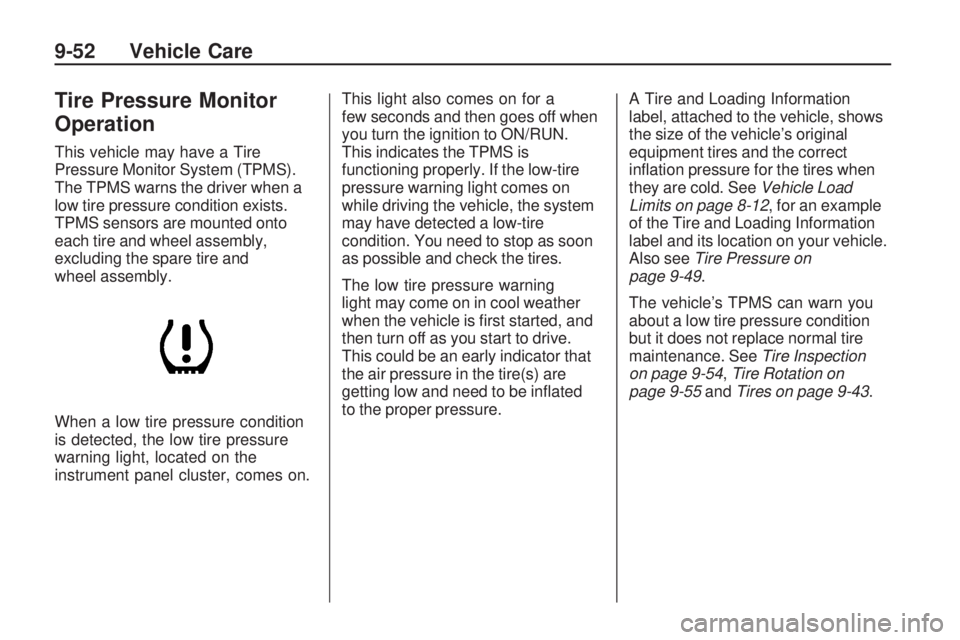
Tire Pressure Monitor
Operation
This vehicle may have a Tire
Pressure Monitor System (TPMS).
The TPMS warns the driver when a
low tire pressure condition exists.
TPMS sensors are mounted onto
each tire and wheel assembly,
excluding the spare tire and
wheel assembly.
When a low tire pressure condition
is detected, the low tire pressure
warning light, located on the
instrument panel cluster, comes on.This light also comes on for a
few seconds and then goes off when
you turn the ignition to ON/RUN.
This indicates the TPMS is
functioning properly. If the low-tire
pressure warning light comes on
while driving the vehicle, the system
may have detected a low-tire
condition. You need to stop as soon
as possible and check the tires.
The low tire pressure warning
light may come on in cool weather
when the vehicle is first started, and
then turn off as you start to drive.
This could be an early indicator that
the air pressure in the tire(s) are
getting low and need to be inflated
to the proper pressure.
A Tire and Loading Information
label, attached to the vehicle, shows
the size of the vehicle’s original
equipment tires and the correct
inflation pressure for the tires when
they are cold. See
Vehicle Load
Limits on page 8-12, for an example
of the Tire and Loading Information
label and its location on your vehicle.
Also see Tire Pressure on
page 9-49.
The vehicle’s TPMS can warn you
about a low tire pressure condition
but it does not replace normal tire
maintenance. See Tire Inspection
on page 9-54, Tire Rotation on
page 9-55 andTires on page 9-43.
9-52 Vehicle Care
Page 237 of 318

TPMS Malfunction Light
The TPMS will not function properly
if one or more of the TPMS sensors
are missing or inoperable. When the
system detects a malfunction, the
low tire warning light flashes for
about one minute and then stays
on for the remainder of the ignition
cycle. The low tire warning light
comes on at each ignition cycle until
the problem is corrected. Some of
the conditions that can cause the
malfunction light to come on are:
•One of the road tires has been
replaced with the spare tire.
The spare tire does not have
a TPMS sensor. The TPMS
malfunction light and DIC
message should go off once
you re-install the road tire
containing the TPMS sensor.
•The initialization (reset) procedure
failed. See “TPMS Reset” later in
this section.
•One or more TPMS sensors
are missing or damaged.
The TPMS malfunction light
should go off when the TPMS
sensors are installed and the
sensor matching process is
performed successfully. See
your dealer/retailer for service.
•Replacement tires or wheels do
not match the vehicle’s original
equipment tires or wheels. Tires
and wheels other than those
recommended for your vehicle
could prevent the TPMS from
functioning properly. SeeBuying
New Tires on page 9-56.
•Operating electronic devices or
being near facilities using radio
wave frequencies similar to the
TPMS could cause the TPMS
sensors to malfunction.
•If tire chains are installed on the
vehicle.
•If there is a lot of snow or ice
around the wheels or wheel
housings.
•If a window tint that affects the
radio wave signals is installed.
If the TPMS is not functioning it
cannot detect or signal a low tire
condition. See your dealer/retailer for
service if the TPMS malfunction light
comes on and stays on.
Vehicle Care 9-53
Page 238 of 318

TPMS Reset
The TPMS sensors and transmitters
have unique identification codes.
Anytime you replace a TPMS sensor
or transmitter the identification codes
need to be registered and the TPMS
needs to be reset (initialized). When
the system is initialized, the current
air pressure in the tires is set as the
tire pressure benchmark. The tire
pressure warning system determines
decreased air pressure by comparing
tire pressure to the benchmark
pressure stored in the TPMS.
Do not reset the TPMS without first
correcting the cause of a low-tire
condition.
To reset the system:
1. Park the vehicle at a safe placeand apply the parking brake.
Turn the engine off.
2. Turn the ignition to ACC/ACCESSORY or
LOCK/OFF. 3. Adjust the tire pressure of all the
installed tires to the specified
cold tire inflation pressure level
indicated on the Tire and Loading
Information label attached to
the vehicle.
4. Turn the ignition to ON/RUN with the engine off.
5. Press and hold the tire pressure warning reset switch until the tire
pressure warning light flashes
slowly on/off three times.
Wait for a few minutes with the
ignition in ON/RUN, and then turn
the ignition to ACC/ACCESSORY
or LOCK/OFF. If the low-tire pressure warning
light does not flash three times
while you press and hold the
reset button, the reset has failed.
Repeat the reset process. If the
reset cannot be performed, see
your dealer/retailer for service.
If you press the tire pressure reset
switch while the vehicle is moving,
the reset is not performed. If you
press the tire pressure reset switch
accidentally and initialization is
performed, adjust the tire pressure to
the specified level and perform the
reset procedure again.
Tire Inspection
We recommend that you
regularly inspect your vehicle’s
tires, including the spare tire, if
the vehicle has one, for signs of
wear or damage. See When It Is
Time for New Tires on page 9-56
for more information.
9-54 Vehicle Care
Page 239 of 318
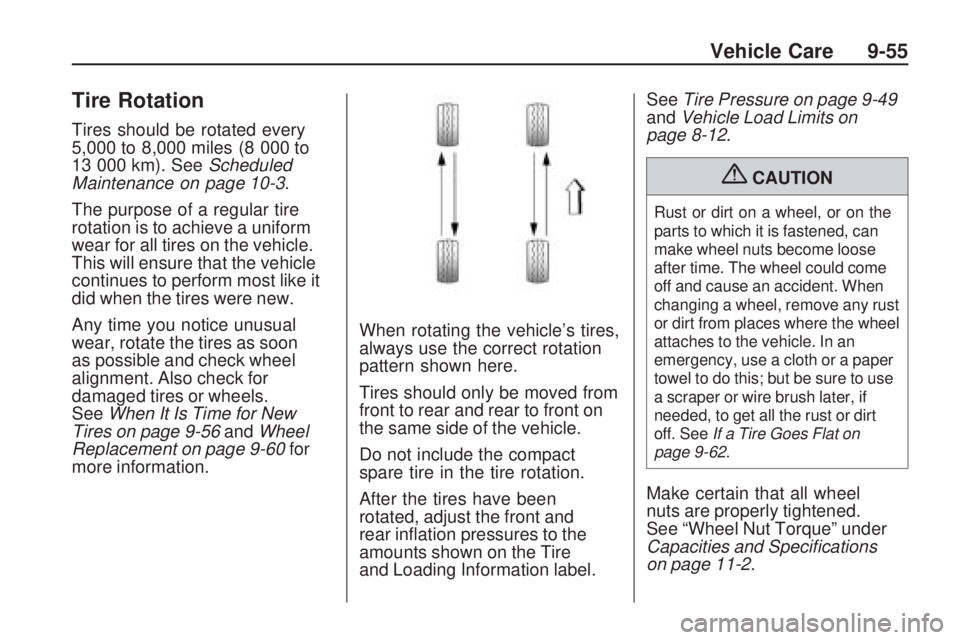
Tire Rotation
Tires should be rotated every
5,000 to 8,000 miles (8 000 to
13 000 km). SeeScheduled
Maintenance on page 10-3.
The purpose of a regular tire
rotation is to achieve a uniform
wear for all tires on the vehicle.
This will ensure that the vehicle
continues to perform most like it
did when the tires were new.
Any time you notice unusual
wear, rotate the tires as soon
as possible and check wheel
alignment. Also check for
damaged tires or wheels.
See When It Is Time for New
Tires on page 9-56 andWheel
Replacement on page 9-60 for
more information. When rotating the vehicle’s tires,
always use the correct rotation
pattern shown here.
Tires should only be moved from
front to rear and rear to front on
the same side of the vehicle.
Do not include the compact
spare tire in the tire rotation.
After the tires have been
rotated, adjust the front and
rear inflation pressures to the
amounts shown on the Tire
and Loading Information label.See
Tire Pressure on page 9-49
and Vehicle Load Limits on
page 8-12.
{CAUTION
Rust or dirt on a wheel, or on the
parts to which it is fastened, can
make wheel nuts become loose
after time. The wheel could come
off and cause an accident. When
changing a wheel, remove any rust
or dirt from places where the wheel
attaches to the vehicle. In an
emergency, use a cloth or a paper
towel to do this; but be sure to use
a scraper or wire brush later, if
needed, to get all the rust or dirt
off. See If a Tire Goes Flat on
page 9-62.
Make certain that all wheel
nuts are properly tightened.
See “Wheel Nut Torque” under
Capacities and Speci�cations
on page 11-2.
Vehicle Care 9-55
Page 240 of 318
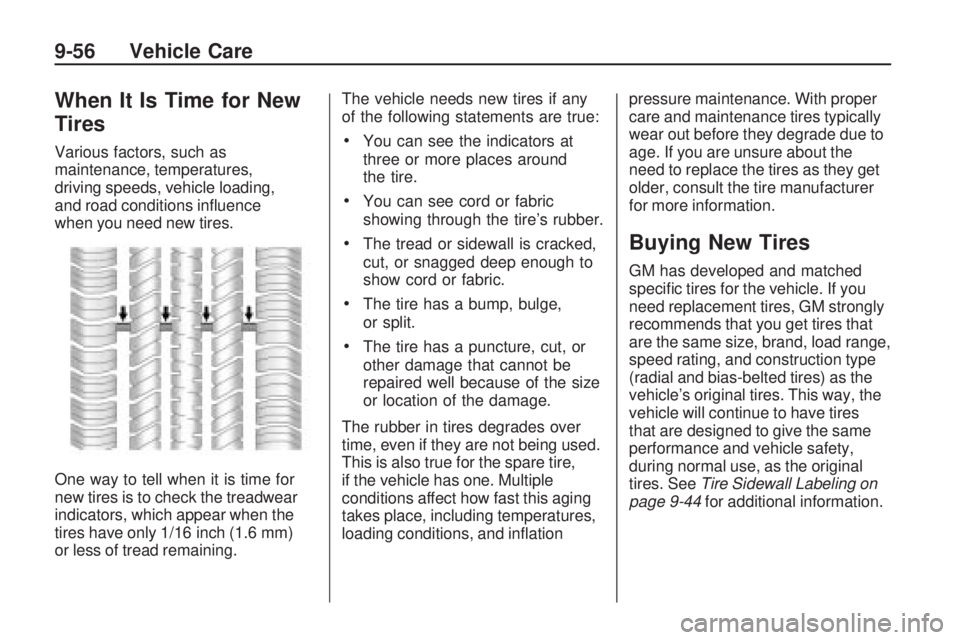
When It Is Time for New
Tires
Various factors, such as
maintenance, temperatures,
driving speeds, vehicle loading,
and road conditions influence
when you need new tires.
One way to tell when it is time for
new tires is to check the treadwear
indicators, which appear when the
tires have only 1/16 inch (1.6 mm)
or less of tread remaining.The vehicle needs new tires if any
of the following statements are true:•You can see the indicators at
three or more places around
the tire.
•You can see cord or fabric
showing through the tire’s rubber.
•The tread or sidewall is cracked,
cut, or snagged deep enough to
show cord or fabric.
•The tire has a bump, bulge,
or split.
•The tire has a puncture, cut, or
other damage that cannot be
repaired well because of the size
or location of the damage.
The rubber in tires degrades over
time, even if they are not being used.
This is also true for the spare tire,
if the vehicle has one. Multiple
conditions affect how fast this aging
takes place, including temperatures,
loading conditions, and inflation pressure maintenance. With proper
care and maintenance tires typically
wear out before they degrade due to
age. If you are unsure about the
need to replace the tires as they get
older, consult the tire manufacturer
for more information.
Buying New Tires
GM has developed and matched
specific tires for the vehicle. If you
need replacement tires, GM strongly
recommends that you get tires that
are the same size, brand, load range,
speed rating, and construction type
(radial and bias-belted tires) as the
vehicle’s original tires. This way, the
vehicle will continue to have tires
that are designed to give the same
performance and vehicle safety,
during normal use, as the original
tires. See
Tire Sidewall Labeling on
page 9-44 for additional information.
9-56 Vehicle Care